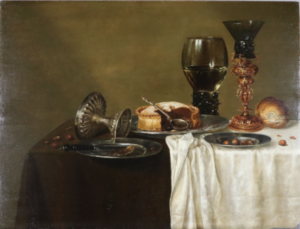Cleaning out the basement can be a hassle for anyone that has one. Things pile up, and it’s easy to forget what you have down there. But it may be difficult to forget that there’s a masterpiece from the Dutch Golden Age just lying around collecting dust. But that’s what recently happened at an Australian museum when they decided to go through an old storeroom.
The Woodford Academy is located in a small village in the Blue Mountains of New South Wales, about an hour outside of Sydney. The cluster of buildings was originally constructed as an inn before becoming a private residence and then a boarding school. In 1979, the property was donated to the National Trust of Australia and turned into a museum. As part of an ongoing art restoration project, the Woodford Academy sent around thirty paintings to conservators, who later found a very exciting signature on the still-life in question. While the National Trust now knows that it’s a still-life created around 1640, it is not entirely known who created the painting despite the signature. It could be Willem Claesz. Heda, considered one of the most prolific still-life painters of the Dutch Golden Age. However, the work could also be by his son Gerret Willemsz. Heda, whose signature is very similar to his father’s. Because of this similarity, art historians attributed nearly all of the younger Heda’s work to his father before 1945. Some art historians theorize that the still-life in question could be a collaboration between the two. But that’s all we have right now: theories.
The untitled still-life shows a table with a half-eaten pie, some glassware, an overturned goblet, a bread roll, and a plate of nuts. This sort of still-life painting is very similar to a style known as vanitas, which was incredibly popular in the Netherlands throughout the sixteenth and seventeenth centuries. Masters of still-life like Pieter Claesz and Harmen Steenwijck became incredibly well known for these works. They often include a table set with timepieces, burnt-out candles, instruments, half-eaten food, mirrors, and, most iconically, skulls. They convey messages about our own mortality, and that we all must make good decisions on how we spend our time. In many of Heda’s still-lifes, including the one discovered at Woodford Academy, one of the plates is set on the table’s edge, part of it hanging off. According to the National Trust’s collections manager Rebecca Pinchin, this continues the vanitas themes, conveying “the transient nature of life – one minute you have comfort and pleasure, the next you can fall into bad times.”
It’s believed that the painting arrived in Australia because of Alfred Fairfax, who probably bought the work while he owned Woodford House as his private retreat until 1897. While it was originally said to be worth $200K, experts’ estimates shot up to $5 million after specialists discovered the signature. It’s not unheard of for a work by the older Heda, but it may be more reasonable given the draw of the story behind it. It is no doubt an incredible find, and will likely draw art lovers and history buffs alike to a regional museum. The Heda still-life will be displayed at the Woodford Academy for the Australian Heritage festival starting on May 14th.

